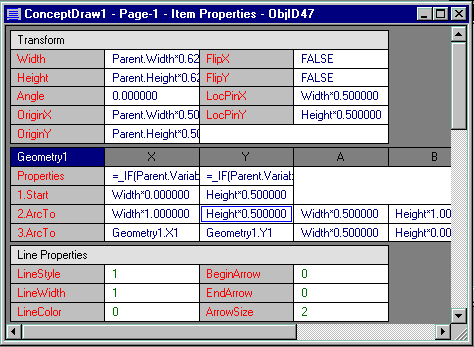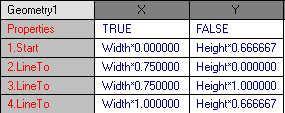
Each ConceptDraw object is determined by dozens of parameters, such as numbers, text or formulas.
All the parameters are brought together in the table, where each of them can be modified. To call the table of an object, select it and choose Show Table from the Figure menu, or press the F3 key. This will open the object's table in a new window.

The input field is at the top of the window. When you select a cell in the table, its contents appears in the input field where it can be edited. Double clicking a cell selects its data that appear in the input field. To finish editing, press the Enter key to return to the initial values press the Esc key (you may also click the respective icons to the left of the input field).
A cell is the place where the program stores a parameter of an object. Once a cell is active, you may edit its contents in the input field at the top of the table window. To quickly start editing, double click the cell. You may use the arrow keys to change the active cell.
What you see in the cell depends on the viewing mode set for the table. These modes are the Values mode and the Formulas mode. When in the Values mode, all cells show the values in the current units of measure of the document. When the Formulas mode is on, all cells that have formulas in them display the formulas. The cells which have no formulas, show the values in the tenths of millimetre. Note, that if a cell contains a formula, the input field will always contain a formula when you select the cell, regardless of the viewing mode.
Not every cell allows to input a formula in it. Some support only numeric values. The cells that allow formulas display their contents in blue, the rest display the values in green.

You can input values in units of measure other than default. For instance: 12 in, 3.5 ft, 0.66 m.
When editing the contents of a cell, you may use the data of
another cell, by clicking that cell with the mouse:
Single click - adds its formula to the input field.
Click with the Ctrl(Win)/Cmd(Mac) down - adds the numeric value
to the input field.
Click with the Alt down - adds the name of the cell (to refer to
it in formulas).
By using formulas, you can make one parameter of an object dependent upon other parameters, or upon the actions of the user. Here are some examples of formulas:
*). Variables.X1+(Variables.X2-Variables.X1)*0.293
*). _min(0;Geometry1.X2-Variables.X2)
*).
=_IF(Variables.X1=1;_Setf("Variables.X1";0);_Setf("Variables.X1";1))
If you want to address a contents of a cell, in a formula indicate the name of the cell (it appears in red near the cell). For instance: Width, TextAngle, etc.
For sections, where you can add cells (sections as Geometry,
Controls, Connect, Variables, Font Format, Paragraph Format,
Actions), other addressing is used:
<section name>.<cell name>
The section name is composed of the column name and the string
number.
For example: "Controls.YDyn1";
"Variables.Y2"; "Connect.X1"
For the Geometry section, the section name also includes the
section number - because a figure may have more than one
geometry. For example: Geometry1.Y1, Geometry2.C2. So, for the
first two cells the names look like this:
"Geometry1.Visible" and "Geometry1.Filled"
Formulas often include functions. The full list of functions and their specifics can be found in the Functions section.
Another case is when you want to address cells that describe
other objects. Every object has its identification number (you
may see it in the title bar of the table window, or in the Information dialog, ID
section). This ID is used when addressing the parameters of the
object: "ObjID13.Geometry2.X1" or
"ObjID2.Width".
If the object belong to a group, you should use the Parent prefix
to address parameters of the group. For instance:
"Parent.Height"
If you address objects within a group, it looks like this:
"Child2.Angle". The number after the name corresponds
to the order of the object within the group. You may see this
number in the Information
dialog (SubID field).
The program may create some formulas automatically. Such formulas are called default formulas. For instance, when we create a line, the program will describe one of its parts as follows:

Here, Width*0.75000 and Height*0.666667 are default formulas. Due to the formulas, vertices maintain their positions with respect to the alignment box of the object when the object is resized. This formulas change when you reposition vertices or the object.
If a formula has the "=" sign near it, it means that the user can't alter the formula, unless s/he edits its cell. If the formula hasn't the "=" sign before it, it may be altered when you apply actions to the parameter it represents.